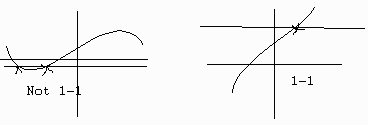1.4: Composition and Inverses
- Page ID
- 224
\( \newcommand{\vecs}[1]{\overset { \scriptstyle \rightharpoonup} {\mathbf{#1}} } \)
\( \newcommand{\vecd}[1]{\overset{-\!-\!\rightharpoonup}{\vphantom{a}\smash {#1}}} \)
\( \newcommand{\dsum}{\displaystyle\sum\limits} \)
\( \newcommand{\dint}{\displaystyle\int\limits} \)
\( \newcommand{\dlim}{\displaystyle\lim\limits} \)
\( \newcommand{\id}{\mathrm{id}}\) \( \newcommand{\Span}{\mathrm{span}}\)
( \newcommand{\kernel}{\mathrm{null}\,}\) \( \newcommand{\range}{\mathrm{range}\,}\)
\( \newcommand{\RealPart}{\mathrm{Re}}\) \( \newcommand{\ImaginaryPart}{\mathrm{Im}}\)
\( \newcommand{\Argument}{\mathrm{Arg}}\) \( \newcommand{\norm}[1]{\| #1 \|}\)
\( \newcommand{\inner}[2]{\langle #1, #2 \rangle}\)
\( \newcommand{\Span}{\mathrm{span}}\)
\( \newcommand{\id}{\mathrm{id}}\)
\( \newcommand{\Span}{\mathrm{span}}\)
\( \newcommand{\kernel}{\mathrm{null}\,}\)
\( \newcommand{\range}{\mathrm{range}\,}\)
\( \newcommand{\RealPart}{\mathrm{Re}}\)
\( \newcommand{\ImaginaryPart}{\mathrm{Im}}\)
\( \newcommand{\Argument}{\mathrm{Arg}}\)
\( \newcommand{\norm}[1]{\| #1 \|}\)
\( \newcommand{\inner}[2]{\langle #1, #2 \rangle}\)
\( \newcommand{\Span}{\mathrm{span}}\) \( \newcommand{\AA}{\unicode[.8,0]{x212B}}\)
\( \newcommand{\vectorA}[1]{\vec{#1}} % arrow\)
\( \newcommand{\vectorAt}[1]{\vec{\text{#1}}} % arrow\)
\( \newcommand{\vectorB}[1]{\overset { \scriptstyle \rightharpoonup} {\mathbf{#1}} } \)
\( \newcommand{\vectorC}[1]{\textbf{#1}} \)
\( \newcommand{\vectorD}[1]{\overrightarrow{#1}} \)
\( \newcommand{\vectorDt}[1]{\overrightarrow{\text{#1}}} \)
\( \newcommand{\vectE}[1]{\overset{-\!-\!\rightharpoonup}{\vphantom{a}\smash{\mathbf {#1}}}} \)
\( \newcommand{\vecs}[1]{\overset { \scriptstyle \rightharpoonup} {\mathbf{#1}} } \)
\( \newcommand{\vecd}[1]{\overset{-\!-\!\rightharpoonup}{\vphantom{a}\smash {#1}}} \)
\(\newcommand{\avec}{\mathbf a}\) \(\newcommand{\bvec}{\mathbf b}\) \(\newcommand{\cvec}{\mathbf c}\) \(\newcommand{\dvec}{\mathbf d}\) \(\newcommand{\dtil}{\widetilde{\mathbf d}}\) \(\newcommand{\evec}{\mathbf e}\) \(\newcommand{\fvec}{\mathbf f}\) \(\newcommand{\nvec}{\mathbf n}\) \(\newcommand{\pvec}{\mathbf p}\) \(\newcommand{\qvec}{\mathbf q}\) \(\newcommand{\svec}{\mathbf s}\) \(\newcommand{\tvec}{\mathbf t}\) \(\newcommand{\uvec}{\mathbf u}\) \(\newcommand{\vvec}{\mathbf v}\) \(\newcommand{\wvec}{\mathbf w}\) \(\newcommand{\xvec}{\mathbf x}\) \(\newcommand{\yvec}{\mathbf y}\) \(\newcommand{\zvec}{\mathbf z}\) \(\newcommand{\rvec}{\mathbf r}\) \(\newcommand{\mvec}{\mathbf m}\) \(\newcommand{\zerovec}{\mathbf 0}\) \(\newcommand{\onevec}{\mathbf 1}\) \(\newcommand{\real}{\mathbb R}\) \(\newcommand{\twovec}[2]{\left[\begin{array}{r}#1 \\ #2 \end{array}\right]}\) \(\newcommand{\ctwovec}[2]{\left[\begin{array}{c}#1 \\ #2 \end{array}\right]}\) \(\newcommand{\threevec}[3]{\left[\begin{array}{r}#1 \\ #2 \\ #3 \end{array}\right]}\) \(\newcommand{\cthreevec}[3]{\left[\begin{array}{c}#1 \\ #2 \\ #3 \end{array}\right]}\) \(\newcommand{\fourvec}[4]{\left[\begin{array}{r}#1 \\ #2 \\ #3 \\ #4 \end{array}\right]}\) \(\newcommand{\cfourvec}[4]{\left[\begin{array}{c}#1 \\ #2 \\ #3 \\ #4 \end{array}\right]}\) \(\newcommand{\fivevec}[5]{\left[\begin{array}{r}#1 \\ #2 \\ #3 \\ #4 \\ #5 \\ \end{array}\right]}\) \(\newcommand{\cfivevec}[5]{\left[\begin{array}{c}#1 \\ #2 \\ #3 \\ #4 \\ #5 \\ \end{array}\right]}\) \(\newcommand{\mattwo}[4]{\left[\begin{array}{rr}#1 \amp #2 \\ #3 \amp #4 \\ \end{array}\right]}\) \(\newcommand{\laspan}[1]{\text{Span}\{#1\}}\) \(\newcommand{\bcal}{\cal B}\) \(\newcommand{\ccal}{\cal C}\) \(\newcommand{\scal}{\cal S}\) \(\newcommand{\wcal}{\cal W}\) \(\newcommand{\ecal}{\cal E}\) \(\newcommand{\coords}[2]{\left\{#1\right\}_{#2}}\) \(\newcommand{\gray}[1]{\color{gray}{#1}}\) \(\newcommand{\lgray}[1]{\color{lightgray}{#1}}\) \(\newcommand{\rank}{\operatorname{rank}}\) \(\newcommand{\row}{\text{Row}}\) \(\newcommand{\col}{\text{Col}}\) \(\renewcommand{\row}{\text{Row}}\) \(\newcommand{\nul}{\text{Nul}}\) \(\newcommand{\var}{\text{Var}}\) \(\newcommand{\corr}{\text{corr}}\) \(\newcommand{\len}[1]{\left|#1\right|}\) \(\newcommand{\bbar}{\overline{\bvec}}\) \(\newcommand{\bhat}{\widehat{\bvec}}\) \(\newcommand{\bperp}{\bvec^\perp}\) \(\newcommand{\xhat}{\widehat{\xvec}}\) \(\newcommand{\vhat}{\widehat{\vvec}}\) \(\newcommand{\uhat}{\widehat{\uvec}}\) \(\newcommand{\what}{\widehat{\wvec}}\) \(\newcommand{\Sighat}{\widehat{\Sigma}}\) \(\newcommand{\lt}{<}\) \(\newcommand{\gt}{>}\) \(\newcommand{\amp}{&}\) \(\definecolor{fillinmathshade}{gray}{0.9}\)Composition of Functions
Example \(\PageIndex{1}\)
Sociologists in Holland determine that the number of people \(y\) waiting in a water ride at an amusement park is given by
\[y = \dfrac{1}{50}C^2 + C + 2 \nonumber \]
where \(C\) is the temperature in degrees \(C\). The formula to convert Fahrenheit to Celsius \(C\) is given by
\[C = \dfrac{5}{9}F + \dfrac{160}{9}. \nonumber \]
To get a function of \(F\) we compose the two function:
\[y(C(F)) = \left(\dfrac{1}{50}\right)\left[\dfrac{5}{9}F + \dfrac{160}{9}\right]^2 + \left[\dfrac{5}{9}F + \dfrac{160}{9}\right] + 2 \nonumber \]
Exercise \(\PageIndex{1}\)
If
- \(f(x) = 3x + 2\)
- \(g(x) = 2x^2 + 1\)
- \(h(x) = \sqrt{x-2}\)
- \(c(x) = 4\)
Find
- \(f(g(x))\)
- \(f(h(x))\)
- \(f(f(x))\)
- \(h(c(x))\)
- \(c(f(g(h(x))))\)
1-1 Functions
Definition: 1-1 (one-to-one)
A function \(f(x)\) is 1-1 if
\[f(a) = f(b)\]
implies that
\[a = b.\]
Example \(\PageIndex{2}\)
If
\[f(x) = 3x + 1 \nonumber\]
then
\[3a + 1 = 3b + 1 \nonumber\]
implies that
\[3a = 3b \nonumber\]
hence
\[a = b \nonumber\]
therefore \(f(x)\) is 1-1.
Example \(\PageIndex{3}\)
If
\[f(x) = x^2 \nonumber\]
then
\[a^2 = b^2 \nonumber\]
implies that
\[a^2-b^2 = 0 \nonumber\]
or that
\[(a - b)(a + b) = 0 \nonumber\]
hence
\[a = b \text{ or } a = -b \nonumber\]
For example
\[f (2) = f (-2) = 4 \nonumber\]
Hence \(f(x)\) is not 1-1.
Horizontal Line Test
If every horizontal line passes through \(f(x)\) at most once then \(f(x)\) is 1-1.

Inverse Functions
Definition: Inverse function
A function \(g(x)\) is an inverse of \(f(x)\) if
\[f(g(x)) = g(f(x)) = x.\]
Example \(\PageIndex{4}\)
The volume of a lake is modeled by the equation
\[V(t) = \dfrac{1}{125}h^3. \nonumber\]
Show that the inverse is
\[h(N) = 5V^{\frac{1}{3}}. \nonumber\]
Solution: We have
\[h(V(h)) = 5(\dfrac{1}{125}h^3)^{\frac{1}{3}} = \dfrac{5}{5}h = h \nonumber\]
and
\[v(h(V)) = \dfrac{1}{125}(5V^{\frac{1}{3}})^3 = \dfrac{1}{125}(125V) = V. \nonumber\]
Step by Step Process for Finding the Inverse
- Interchange the variables
- Solve for \(y\)
- Write in terms of \(f^{-1}(x)\)
Example\(\PageIndex{5}\)
Find the inverse of
\[f (x) = y = 3x^3 - 5 \nonumber\]
Solution
\[\begin{align} x &= 3y^3 - 5 \\ x + 5 &= 3y^3 \\ \dfrac{(x + 5)}{3} &= y^3 ,\\ \left[\dfrac{(x + 5)}{3}\right]^{\frac{1}{3}}&=y \end{align}\]
\[f^{-1}(x) = \left[\dfrac{(x + 5)}{ 3 }\right]^{\frac{1}{3}}. \nonumber\]
Graphing
To graph an inverse we draw the \(y = x\) line and reflect the graph across this line.
To interactively view the graph of an inverse click here:
mathcsjava.emporia.edu/~greenlar/Inverse/inverse.html
Contributors and Attributions
- Larry Green (Lake Tahoe Community College)
Integrated by Justin Marshall.


